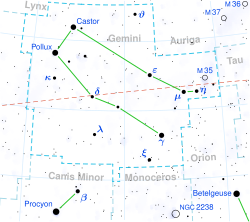Pollux (star)
| Observation data Epoch J2000.0 Equinox J2000.0 |
|
|---|---|
| Constellation | Gemini |
| Right ascension | 07h 45m 18.94987s |
| Declination | +28° 01′ 34.3160″ |
| Apparent magnitude (V) | 1.14 |
| Characteristics | |
| Evolutionary stage | Giant star |
| Spectral type | K0 III |
| U−B color index | +0.86 |
| B−V color index | +1.00 |
| Variable type | Suspected |
| Astrometry | |
| Radial velocity (Rv) | +3.23 km/s |
| Proper motion (μ) |
RA: –626.55 mas/yr Dec.: –45.80 mas/yr |
| Parallax (π) | 96.54 ± 0.27mas |
| Distance | 33.78 ± 0.09 ly (10.36 ± 0.03 pc) |
| Absolute magnitude (MV) | +1.08±0.02 |
| Details | |
| Mass | 2.04±0.3 M☉ |
| Radius | 8.8±0.1 R☉ |
| Luminosity | 43 L☉ |
| Surface gravity (log g) | 2.685±0.09 cgs |
| Temperature | 4666±95 K |
| Metallicity [Fe/H] | –0.07 to +0.19 dex |
| Rotation | 558 days |
| Rotational velocity (v sin i) | 2.8 km/s |
| Age | 724 Myr |
| Other designations | |
| Database references | |
| SIMBAD | data |
| ARICNS | data |
Pollux, also designated Beta Geminorum (β Geminorum, abbreviated Beta Gem, β Gem), is an orange-hued evolved giant star approximately 34 light-years from the Sun in the northern constellation of Gemini. It is the closest giant star to the Sun.
Since 1943, the spectrum of this star has served as one of the stable anchor points by which other stars are classified. In 2006, an extrasolar planet (designated Pollux b or β Gem b, later named Thestias) was confirmed to be orbiting it.
β Geminorum (Latinised to Beta Geminorum) is the star's Bayer designation.
The traditional name Pollux refers specifically to the twins Castor and Pollux in Greek and Roman mythology. In 2016, the International Astronomical Union organized a Working Group on Star Names (WGSN) to catalog and standardize proper names for stars. The WGSN's first bulletin of July 2016 included a table of the first two batches of names approved by the WGSN; which included Pollux for this star.
Castor and Pollux are the two "heavenly twin" stars giving the constellation Gemini (Latin, 'the twins') its name. The stars, however, are quite different in detail. Castor is a complex sextuple system of hot, bluish-white A-type stars and dim red dwarfs, while Pollux is a single, cooler yellow-orange giant. In Percy Shelley's 1818 poem Homer's Hymn To Castor And Pollux, the star is referred to as "..mild Pollux, void of blame."
...
Wikipedia

